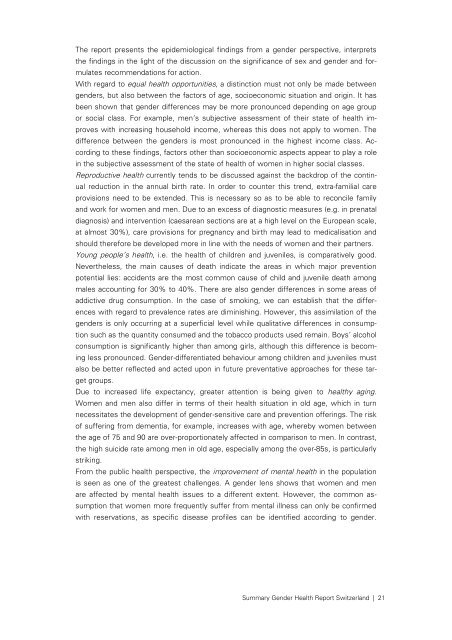Gender-Gesundheitsbericht Schweiz 2006 - Gender Campus
Gender-Gesundheitsbericht Schweiz 2006 - Gender Campus
Gender-Gesundheitsbericht Schweiz 2006 - Gender Campus
Erfolgreiche ePaper selbst erstellen
Machen Sie aus Ihren PDF Publikationen ein blätterbares Flipbook mit unserer einzigartigen Google optimierten e-Paper Software.
The report presents the epidemiological findings from a gender perspective, interprets<br />
the findings in the light of the discussion on the significance of sex and gender and formulates<br />
recommendations for action.<br />
With regard to equal health opportunities, a distinction must not only be made between<br />
genders, but also between the factors of age, socioeconomic situation and origin. It has<br />
been shown that gender differences may be more pronounced depending on age group<br />
or social class. For example, men’s subjective assessment of their state of health improves<br />
with increasing household income, whereas this does not apply to women. The<br />
difference between the genders is most pronounced in the highest income class. According<br />
to these findings, factors other than socioeconomic aspects appear to play a role<br />
in the subjective assessment of the state of health of women in higher social classes.<br />
Reproductive health currently tends to be discussed against the backdrop of the continual<br />
reduction in the annual birth rate. In order to counter this trend, extra-familial care<br />
provisions need to be extended. This is necessary so as to be able to reconcile family<br />
and work for women and men. Due to an excess of diagnostic measures (e.g. in prenatal<br />
diagnosis) and intervention (caesarean sections are at a high level on the European scale,<br />
at almost 30%), care provisions for pregnancy and birth may lead to medicalisation and<br />
should therefore be developed more in line with the needs of women and their partners.<br />
Young people’s health, i.e. the health of children and juveniles, is comparatively good.<br />
Nevertheless, the main causes of death indicate the areas in which major prevention<br />
potential lies: accidents are the most common cause of child and juvenile death among<br />
males accounting for 30% to 40%. There are also gender differences in some areas of<br />
addictive drug consumption. In the case of smoking, we can establish that the differences<br />
with regard to prevalence rates are diminishing. However, this assimilation of the<br />
genders is only occurring at a superficial level while qualitative differences in consumption<br />
such as the quantity consumed and the tobacco products used remain. Boys’ alcohol<br />
consumption is significantly higher than among girls, although this difference is becoming<br />
less pronounced. <strong>Gender</strong>-differentiated behaviour among children and juveniles must<br />
also be better reflected and acted upon in future preventative approaches for these target<br />
groups.<br />
Due to increased life expectancy, greater attention is being given to healthy aging.<br />
Women and men also differ in terms of their health situation in old age, which in turn<br />
necessitates the development of gender-sensitive care and prevention offerings. The risk<br />
of suffering from dementia, for example, increases with age, whereby women between<br />
the age of 75 and 90 are over-proportionately affected in comparison to men. In contrast,<br />
the high suicide rate among men in old age, especially among the over-85s, is particularly<br />
striking.<br />
From the public health perspective, the improvement of mental health in the population<br />
is seen as one of the greatest challenges. A gender lens shows that women and men<br />
are affected by mental health issues to a different extent. However, the common assumption<br />
that women more frequently suffer from mental illness can only be confirmed<br />
with reservations, as specific disease profiles can be identified according to gender.<br />
Summary <strong>Gender</strong> Health Report Switzerland | 21













